Stage 1
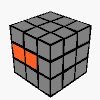
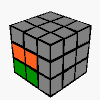
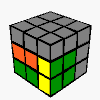
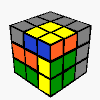
|
Land of the squares...
In stage 1, the goal is to build 4 square-shaped blocks. These squares need not be joined together by matching colours, as you can see; we will do that in a later step. However, it is important to fit the squares together snugly by their shape, as this frees up more of the cube for performing later maneuvers.
Notice that there are two kinds of square that can be built:
| Inner square | Outer square |
|---|---|
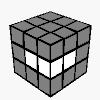
|
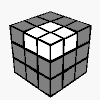
|
This brings us to the rules for stage 1:
- Stage 1 must consist of exactly 1 inner square and 3 outer squares.
- Stage 1 must use only 5 out of the cube's 6 colours.
Building the 1st square
The squares can be built in any order, although it is often more efficient to begin with an outer square.
An outer square is built in three steps:

|
+ |
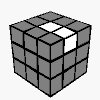
|
→ |

|
-
Build a corner/edge pair
Find a corner and edge piece that have two colours in common. In the example below, we have chosen the green/orange/yellow corner and the orange/yellow edge. These two pieces can be joined together so that their orange and yellow stickers join with each other. The first step in joining two pieces is to first position them so that their colours are aligned on the same axis. The concept of alignment is illustrated below:
Aligned: Not aligned: If you click play, you will find that the aligned pieces can be joined in one move, but the unaligned pieces cannot.
It follows that once you can get two pieces into an aligned position, joining them is easy.
Practice: Use the applet below to practice joining random corner/edge pairs, or click the "play" button to reveal the solution.
It often happens that a scrambled Rubik's cube contains one or more corner/edge pairs already joined. If you find one, you can use it and continue with the next step.
-
Build a centre/edge pair
A centre/edge pair is built using the same technique of alignment. First, we align the edge piece with the centre piece, and then join them.
However, the difference this time is that we need to preserve what we built in the previous step. There will be a corner/edge pair floating around somewhere on the cube, and we would like to build the centre/edge pair without breaking apart that existing corner/edge pair.
Incorrect Correct The usual technique to avoid breaking the corner/edge pair is to move it out of the way first.
Practice: Use the applet below to practice random positions, or click play to show the solution.
By the end of this step, you should have a corner/edge pair and a centre/edge pair intact.
-
Join the corner/edge and centre/edge pairs to form a square
Once you have formed a corner/edge pair and a centre/edge pair, you can join them once again using the technique of alignment.
Practice: Use the applet below to practice random positions.
Building the 2nd square
The first square was an outer square. We will pick a parallel inner square for the second square, since it can fit perfectly beside the first square. As before, the challenge is to build this square without destroying the first square.
In the example below, the existing (first) square is shown in white, and the second square that we would like to build involves the red/green pieces:
| Incorrect | Correct |
|---|---|
Notice that in the correct solution, the first square (shown in white) is moved out of the way before constructing the inner square.
Once both squares are constructed, they should be joined together so that they do not get in the way of other steps to follow:
Building the 3rd square
Since we have already built the "one and only" inner square, the 3rd square must be another outer square. We can use the same techniques to build it that we used to build the first outer square.
In the example below, the first two moves form a corner/edge pair, the next move moves this pair out of the way, the following move forms a centre/edge pair, the next two moves join these pairs to form the outer square, and the final move fits this new square onto the existing white block so that it will be kept out of the way for the steps that follow.
While the 3rd square can always be built without ever breaking the existing white block, sometimes there are shortcut solutions that involve temporarily breaking this block and then restoring it:
| Standard | Shortcut |
|---|---|
Building the 4th square
At this stage, it becomes quite difficult to add another square without destroying what has been built so far. In fact, some situations will be impossible to solve unless we (temporarily) destroy an existing block. This process of temporarily destroying an existing block will be similar to the shortcut example given above.
From the following position, the 4th square can be solved without destroying the white block:
However, in the following case, the 4th square can only be solved by temporarily destroying the white block:
Depending on which colours you chose for each square, at the end of this stage you will end up with a cube similar to one of the following:
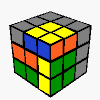
|
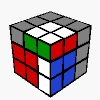
|
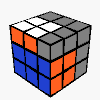
|
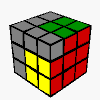
|
Each of the above examples uses only 5 colours. If your stage 1 involves all 6 colours, you have made a mistake somewhere.
Advanced tips and hints for stage 1
Solve difficult bits before easy bits. A corner/edge pair is more difficult to form than a centre/edge pair, and an outer square is more difficult to form than an inner square.
Always store blocks in their best fit position, so as not to obstruct further movement of pieces.
If you see a difficult block already built, or partially built (e.g. pieces aligned but not joined), then make use of it. If you can't make use of it immediately, then try to preserve it (i.e. store it in a best fit position) while solving other parts of the cube.
Try to take advantage of the current state of the cube. For example, in choosing an outer square for your first square, there are 24 different possible squares you could choose from. Pick one that is already partially (or fully) built. For the second square, it is usually best to build the adjacent inner square with matching colours. This will give you 9 possible squares to choose from for building the third square.
Of the 9 possible third squares, 3 match in colour, while 6 do not match. There is not much difference between choosing a matching or non-matching one, so again pick whichever square is closest to being fully built. If you pick one of the squares with matching colours, you will have 4 squares to choose from for the fourth square.
If, on the other hand, you pick one of the non-matching squares as your third square, you will have one square to choose from for the fourth square. In the following example, the fourth square must be the yellow/orange/blue square:
There is, however, an alternative to building a fourth square:
The separate corner/edge pair has the right colours to form part of stage 1, but the centre/edge pair it needs to join with to form a square is already being used in a different square.
We can still make use of this corner/edge pair by joining it onto the existing square to form a rectangle.
Click the play button to view the procedure.
Fortunately there are efficient ways to insert the remaining edge.
Click the play button to see the edge inserted.